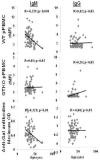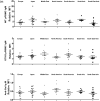Is there a correlation between anti-pig antibody levels in humans and geographic location during childhood?
- PMID: 23887601
- PMCID: PMC3867204
- DOI: 10.1097/TP.0b013e3182992a84
Is there a correlation between anti-pig antibody levels in humans and geographic location during childhood?
Abstract
Background: An initial observation suggested high levels of anti-pig antibodies in healthy humans who had spent their childhood in the Middle East. We tested larger cohorts to determine whether anti-pig antibody levels correlated with the geographic location in which the subject spent his/her childhood, because this might have implications for clinical trials of xenotransplantation.
Methods: Anti-pig IgM and IgG levels (by flow cytometry using peripheral blood mononuclear cells from wild-type and α1,3-galactosyltransferase gene-knockout pigs) and anti-Gal IgM and IgG levels (by enzyme-linked immunosorbent assay) were measured in 75 volunteers. Comparisons of antibody levels were also made based on subject age, gender, ABO blood group, diet, and history of vaccination.
Results: Antibody binding to α1,3-galactosyltransferase gene-knockout pig cells was less than to wild-type cells. There was a reduction in anti-pig IgM and anti-Gal IgM, but a slight increase in anti-nonGal IgG, with age. Women had higher levels of anti-Gal IgM than men. Blood group A subjects had higher levels of anti-pig IgM and IgG than those of group AB. Diet had no influence on antibody levels. Typhoid or measles-mumps-rubella vaccination was associated with lower anti-nonGal IgG or anti-Gal IgG, respectively, whereas influenza vaccination was associated with higher anti-nonGal IgG. There were some significant variations in antibody levels associated with location during childhood, with subjects from the Middle East demonstrating higher anti-nonGal IgG and anti-Gal IgG.
Conclusion: Clinical trials of xenotransplantation may be influenced by various factors, including the geographic location of the recipient during childhood, possibly associated with exposure to different microorganisms.
Conflict of interest statement
There are no other conflicts of interest for all the rest of the authors.
Figures




Similar articles
-
Anti-Neu5Gc and anti-non-Neu5Gc antibodies in healthy humans.PLoS One. 2017 Jul 17;12(7):e0180768. doi: 10.1371/journal.pone.0180768. eCollection 2017. PLoS One. 2017. PMID: 28715486 Free PMC article.
-
Minimal effect of bortezomib in reducing anti-pig antibodies in human leukocyte antigen-sensitized patients: a pilot study.Xenotransplantation. 2013 Nov-Dec;20(6):429-37. doi: 10.1111/xen.12052. Epub 2013 Sep 3. Xenotransplantation. 2013. PMID: 23998233 Free PMC article.
-
Anti-gal antibodies in α1,3-galactosyltransferase gene-knockout pigs.Xenotransplantation. 2012 Sep-Oct;19(5):305-10. doi: 10.1111/j.1399-3089.2012.00710.x. Epub 2012 Sep 13. Xenotransplantation. 2012. PMID: 22970769 Free PMC article.
-
The anti-nonGal xenoantibody response to alpha1,3-galactosyltransferase gene knockout pig xenografts.Curr Opin Organ Transplant. 2010 Apr;15(2):207-11. doi: 10.1097/MOT.0b013e328336b854. Curr Opin Organ Transplant. 2010. PMID: 20075731 Free PMC article. Review.
-
Modifying the sugar icing on the transplantation cake.Glycobiology. 2016 Jun;26(6):571-81. doi: 10.1093/glycob/cww028. Epub 2016 Mar 1. Glycobiology. 2016. PMID: 26935763 Free PMC article. Review.
Cited by
-
Are there advantages in the use of specific pathogen-free baboons in pig organ xenotransplantation models?Xenotransplantation. 2014 May-Jun;21(3):287-90. doi: 10.1111/xen.12088. Epub 2014 Feb 18. Xenotransplantation. 2014. PMID: 24547993 Free PMC article.
-
Distribution of Bacterial α1,3-Galactosyltransferase Genes in the Human Gut Microbiome.Front Immunol. 2020 Jan 13;10:3000. doi: 10.3389/fimmu.2019.03000. eCollection 2019. Front Immunol. 2020. PMID: 31998300 Free PMC article.
-
Anti-Neu5Gc and anti-non-Neu5Gc antibodies in healthy humans.PLoS One. 2017 Jul 17;12(7):e0180768. doi: 10.1371/journal.pone.0180768. eCollection 2017. PLoS One. 2017. PMID: 28715486 Free PMC article.
-
Serum Antibody Binding and Cytotoxicity to Pig Cells in Chinese Subjects: Relevance to Clinical Renal Xenotransplantation.Front Immunol. 2022 Mar 10;13:844632. doi: 10.3389/fimmu.2022.844632. eCollection 2022. Front Immunol. 2022. PMID: 35418974 Free PMC article.
References
-
- Almeida IC, Krautz GM, Krettli AU, Travassos LR. Glycoconjugates of Trypanosoma cruzi: a 74 kD antigen of trypomastigotes specifically reacts with lytic anti-alpha-galactosyl antibodies from patients with chronic Chagas disease. J Clin Lab Anal. 1993;7:307–316. - PubMed
-
- Avila JL, Rojas M, Galili U. Immunogenic Gal alpha1-3Gal carbohydrate epitopes are present on pathogenic American Trypanosoma and Leishmania. J Immunol. 1989;142:2828–2834. - PubMed
-
- Avila JL. Alpha-Galactosyl-bearing epitopes as potent immunogens in Chagas' disease and leishmaniasis. Subcell Biochem. 1999;32:173–213. - PubMed
Publication types
MeSH terms
Substances
Grants and funding
LinkOut - more resources
Full Text Sources
Other Literature Sources

